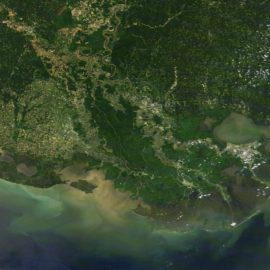
A company that has polluted Lake Charles is cleaning up their act – an act of good will? No it was because they settled with the EPA.
A chemical company with a long track record of explosions, spills and air-quality violations in Louisiana has agreed to spend $110 million on plant upgrades that federal regulators say will greatly reduce air pollution in the Lake Charles area. In a settlement reached with the U.S. Environmental Protection Agency, the Houston-based Westlake Corp. will make plant improvements in response to allegations that the company violated state and federal air pollution laws at two facilities near Lake Charles and one in Calvert City, Kentucky. The company, which had called itself Westlake Chemical until early this year, must also pay $1 million in civil penalties. According to the EPA, which filed a complaint with the states of Louisiana and Kentucky, Westlake and its subsidiaries failed to properly operate and monitor their industrial flares, which resulted in excess emissions of air pollution at the three plants. The company regularly “oversteamed” the flares and failed to comply with other standard operating constraints to ensure pollutants contained in the gases were burned by the flares combusted, according to the EPA.
nola.com
Thousands of tons of emissions will be eliminated which begs the question of why did they have to be told to do it rather than doing it as normal company policy.
The plant upgrades will eliminate thousands of tons of air pollution from flares in Louisiana and Kentucky, EPA officials estimate. “The settlement’s significant reductions of hazardous and other air pollutants and greenhouse gases will serve to reduce exposure in the vulnerable nearby communities with environmental justice concerns,” said Todd Kim of the U.S. Department of Justice’s environment division. A Westlake spokesperson said the company was “pleased to have reached an agreement” with the EPA. “Westlake Corporation is committed to operating in a safe and environmentally responsible manner,” the spokesperson said. “The company works to ensure compliance with state and federal regulatory authorities in minimizing emissions, especially regarding industrial flaring.” Westlake has four large plants within a few miles of each other in Westlake and Sulphur, just west of Lake Charles. Two of the most dangerous incidents at Westlake’s Louisiana plants have occurred over the past nine months. In September, an explosion released harmful gases and injured at least two dozen workers. Federal investigators fined Westlake and three of its contractors $139,000 for nearly a dozen safety violations linked to the explosion. A nearly identical explosion happened at a nearby Westlake plant in January. That blast, which produced a black mushroom-shaped cloud over Lake Charles, injured six people and forced about 7,000 students in more than a dozen schools to shelter in place to prevent exposure to toxic gases.
These are just the big ones. There has been a steady stream of violations over the years.
Westlake’s plants have been faulted by state and federal regulators for several chemical spills and leaks, fires, air and water quality violations, failed safety inspections, and other safety issues over the past 20 years, a review of federal and state records found. Westlake’s plants have the potential to produce much bigger disasters – ones that could imperil tens of thousands of people. The plant known as Lake Charles South could release enough chlorine gas, a substance used as a weapon in World War I, to harm more than 210,000 people, according to company estimates in a special “risk management plan” that The Times-Picayune | New Orleans Advocate reviewed via a Freedom of Information Act request. Another nearby Westlake facility has an overlapping risk zone. Lake Charles North, a vinyl chloride monomer producer about two miles from Lake Charles South, could harm about 211,000 people with a large release of hydrogen chloride, a gas that can corrode eyes and lungs. Roishetta Ozane, a Westlake resident and an organizer for the environmental group Healthy Gulf, said the fact that the plants need $110 million in upgrades hints at just how “outdated and unsafe” Westlake’s plants have been for many years. “These plants should already be safe,” she said. “What do we have to endure while we wait for them to be upgraded?”
There is no timeline for the upgrades but I hope the company moves quickly.
The EPA didn’t give a timeline for implementing the upgrades. The settlement requires Westlake to install air pollution control and monitoring technology to reduce pollution from eight flares at the three facilities. The technology is expected to reduce emissions of volatile organic compounds (VOCs) by more than 2,200 tons per year and toxic air pollutants, including the carcinogen benzene, by 65 tons per year. VOCs are a key producer of smog or ground-level ozone, a pollutant that irritates lungs, worsens asthma, and can trigger pneumonia and bronchitis. Chronic exposure to benzene is blamed for causing leukemia and reproductive problems in women. Flares are also a large source of greenhouse gas emissions. The EPA gave no estimates of pollution reductions for individual plants. The air quality monitoring Westlake is now required to perform is intended to detect benzene at the fence lines of the three plants. Monitoring results must be shared publicly, according to the settlement.
In a perfect world, other polluters will see this clean up and voluntarily do the same at their facilities. I am not holding my breath.



